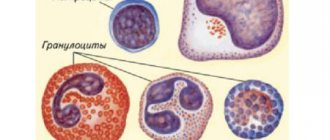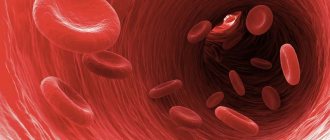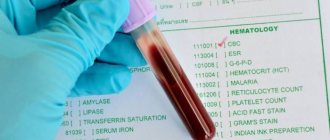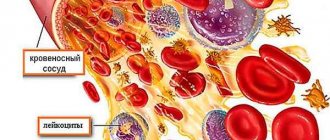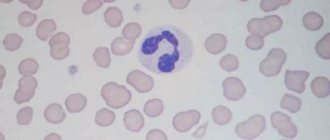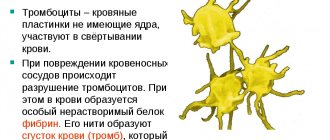What will happen in the video:
1. What are monocytes |
00:22 (in video) 2. Normal monocytes in the blood | 02:49 (in video) 3. Reasons for the increase in monocytes in the blood | 03:42 (in video) 4. Symptoms of increased monocytes in the blood | 06:58 (in video) 5. Increased monocytes in children (monocytosis in children) | 10:39 (in video) Online consultation with infectious disease specialist, allergist-immunologist Natalia Nikolaevna Gordienko
Cost of online consultation: 3500 rubles
Online consultation
During the consultation, you will be able to voice your problem, the doctor will clarify the situation, interpret the tests, answer your questions and give the necessary recommendations.
Read more about blood tests in our article
“Hematological tests: norms and interpretation of results.”
What are monocytes?
A monocyte is a representative of white blood cells. If translated from ancient Greek, then μονος is one, and κύτος is a cell. This is a fairly large cell, which has a large nucleus, slightly eccentrically displaced, and in our body it performs very important functions. To perform its tasks, the so-called janitors or orderlies, it is equipped with special devices.
This cell can have amoeboid movement, it can move independently, like an amoeba, in the liquid part of the blood, and it can have transnasal movement. those. leave its stay in the bloodstream through the thin wall of the blood vessel and, accordingly, rush into certain tissues. Performing its function as an orderly, it has such a powerful property as chemotaxis (the motor reaction of microorganisms to a chemical irritant) and can rush precisely to the sites of inflammation. There, where there are many destroyed cells, where there may be dead bacteria, viruses, dead cells of the body.
Let’s say there is a flu-like condition, and during this period there is a lot of destruction of the epithelial cells of the nasopharynx or oropharynx. And monocytes, during the flu period, will rush there and try to utilize dead cells. By enveloping fairly large pieces of destroyed bacterial cells and digesting them, they will prepare the tissue for reparative processes (recovery processes). They must clean out the field, and in this field, after eliminating the source of inflammation, young, healthy cells will then grow.
The importance of monocytes in the female body
In a woman's body, monocytes perform vital functions. They:
Capable of destroying and neutralizing pathogenic and foreign organisms. Cells are able to swallow them whole
It is important that monocytes “swallow” objects, the number and size of which are very significant. This is beyond the capabilities of other groups of leukocytes. Provide their surface to T-helper cells (helper cells)
The purpose of the latter is to strengthen adaptive immune resistance. It is aimed at the rapid destruction of pathogens wishing to invade the body. Participate in starting the process of necrosis deep in malignant cells. Monocytes have the same cytotoxic effect on malaria pathogens and parasitic protists. Promote the restoration of tissues that have been damaged, inflamed or affected by tumors. Cells (destroyed and dead), antigen-antibody complexes, and foreign bacteria are removed from the body.
Monocytes are irreplaceable, because they can do what other types of leukocytes cannot do: absorb pathogens in a highly acidic environment.
Abnormal cell levels weaken the body because the efficiency of white blood cells decreases. They cannot fully resist viruses and microbes.
Causes of increased monocytes
Out of the blue, just like that, the number of monocytes does not increase. There are certain reasons for this. I want to tell you the main diseases and conditions in which the number of monocytes in the blood will increase.
- Of course, tuberculosis, including extrapulmonary forms of tuberculosis, will come first. It is he who will cause this monocytosis. Unfortunately, today the number of tuberculosis of the extrapulmonary form is beginning to increase widely: kidneys, intestines, skin, spine, lymph nodes, cases of tuberculosis of the lymph nodes have especially increased. In all these conditions, in any form of tuberculosis, a person will always have an increase in the number of lymphocytes.
- Syphilitic lesion. Syphilis is also a systemic disease, and it will also cause monocytosis or an increase in the number of lymphocytes.
- Autoimmune diseases. First of all, diseases of an autoimmune nature of connective tissues: systemic lupus erythematosus, rheumatoid conditions, rheumatoid arthritis, periarthritis nodosa. When immune inflammation occurs in connective tissues. In these conditions there will also be monocytosis.
- Problems of the digestive tract, in particular ulcerative colitis, inflammation of the small intestine, Crohn's disease - these are conditions when the number of lymphocytes in the blood will also increase.
- Cancerous tumors. They will also have monocytosis.
- The recovery period after any inflammatory process of infectious origin. What does it mean? Any infectious disease can cause a state of monocytosis. And if monocytosis develops in diseases not related to tuberculosis or syphilis, then an increase in monocytes will indicate that the infectious process has entered its final stage. In other words, monocytes, having activated into phagocytes, indicate that the inflammatory process is entering its final stage.
- Oddly enough - stress. They can cause monocytosis. It is stress, through a violation of psycho-emotional balance, through the pituitary-hypothalamus zone, through the adrenal systems, that can cause an increase in monocytes.
- Oncological diseases such as lymphomas or Kharchenko's disease. They can also provoke an increase in the number of lymphocytes.
Norm
A general blood test is a productive test. Based on the data, the therapist prescribes treatment or refers the patient for additional examination to other highly specialized specialists.
Acceptable indicators of the total number of leukocytes as a percentage:
- children under 1 year of age – 4 – 10%;
- children from 1 year to 2 years – 3 – 10%;
- over 2 years – 3 – 12%.
Any deviations from standard percentages are considered signs of reduced immunity, the presence of pathology and require careful medical supervision.
Symptoms
How will a person feel, how will he feel? What should motivate a person to go and take a blood test? What symptoms might he have that could lead to an increase in monocytes in the blood?
- This could be causeless weight loss.
- Decreased or complete absence of appetite.
- Increased fatigue. Unreasonable weakness. It seemed like he had gotten enough sleep, he didn’t seem to be overtired, he seemed to be resting, but in the morning he got up and had no strength. This groundless weakness requires mandatory monitoring of blood tests.
- Anxiety, panic attacks, depression, or psycho-emotional agitation. This should also encourage a person to go and do a detailed blood test.
- Irritability, apathy, drowsiness - any disturbance in the psycho-emotional state can cause changes in the peripheral blood.
- Sudden refusal of meat food, even to the point of disgust for meat food. As a rule, monocytosis will be present in a detailed blood test.
- Gastrointestinal disorders: bloating, rapid motility, bowel dysfunction, both constipation and diarrhea, increased secretion of mucus in feces.
- A dry, prolonged cough, sometimes streaked with blood, with scanty sputum.
- Joint and muscle pain in the back and legs. This also requires decoding and examination.
- Specific rashes on the skin and mucous membranes can also be a condition in which there will be monocytosis or an increase in the concentration of monocytes in the blood.
- Presence of rashes on the genitals.
It must be said that all of the above reasons can be disturbing, both individually and collectively, together. Several symptoms unite into entire syndromes. I want to emphasize that an increase in the number of monocytes in the blood in itself is not a diagnosis. This is a state of peripheral blood cells of the immune system, which indicates that not everything is in order in the “state”, and this requires mandatory examination, requires careful attention and further decoding.
How to detect low monocyte levels
Laboratory tests can detect monocytopenia
To detect a low level of monocytes, it is necessary to take a general blood test from a finger prick. It can be prescribed upon request due to symptoms of monocyte deficiency, as well as for any abnormalities in the body.
You can decipher the test results yourself by comparing the indicators in the monocyte line on the coupon with the standard indicators, or by consulting a doctor. The most accurate result will be given by the doctor when he finds out possible concomitant factors and characteristics of your body. In some cases, the doctor may prescribe additional medical tests to more accurately determine the source of the disorder.
Monocytosis in children
Separately, I want to talk about monocytosis in children. This has recently become a fairly common condition, and parents and, unfortunately, not even medical workers always know what to think about with monocytosis and what pathological causes can cause an increase in the number of monocytes in children.
- Firstly, these are diseases caused by bacteria, fungi and viruses. In principle, any of these “friends” can cause an increase in monocytes in the child’s blood.
- Infection with worms. This reason can even be put in first place in children's practice.
- Inflammatory processes in the gastrointestinal tract. And that condition of the gastrointestinal tract, which we call: intestinal dysbiosis, which is also not a diagnosis, but it is the microbiota that can determine the concentration of monocytes and cause monocytosis.
- Food poisoning. And any other poisoning can cause monocytosis in a child’s body.
- Allergic reactions in a child. If we talk about young children, then this is predominantly a genetically determined food allergy. If we talk about older children, then these may be allergic reactions associated with the same parasitosis, helminthic infestations, protozoan infections, or the consumption of food products containing a lot of preservatives, allergens, all kinds of stabilizers, etc., that is, not Completely suitable food for a child.
- Oncological diseases of the blood. Of course, they can also cause monocytosis, and, first of all, these are leukemia and lymphoma.
- Autoimmune pathology of children.
- Rheumatoid arthritis or juvenile rheumatoid arthritis.
- Systemic lupus erythematosus.
- Crohn's disease.
- Infectious processes after surgical interventions can also cause monocytosis, and this will be one of the body’s protective reactions.
If we talk about monocytosis in pediatric practice, then, of course, first of all it will be associated with acute respiratory viral infections, diseases of an infectious nature, and bacterial diseases of the gastrointestinal tract. Therefore, on the one hand, there is no need to be afraid of monocytosis, but on the other hand, this is a blood indicator that can indicate some serious, still hidden problems that are not clearly manifested clinically. And this is a reason to conduct more in-depth research on a specific person.
That’s basically all I wanted to tell you about monocytes. If you have any questions, you can write to us or ask them in the comments. And if everything is clear to you, I was glad to give you this information. Come see us if the need arises and stay healthy.
The norm of monocytes in the blood of women
The content of monocytic cells in female blood is calculated as a percentage of the total number of white blood cells. Information about whether this value corresponds to the norm is found in the leukocyte formula.
The optimal concentration of monocytes is almost independent of age. Before puberty, it should be between three and nine percent. After turning sixteen, the upper limit rises.
The standard content of monocytes in female blood is (%):
- minimum – 3.0;
- maximum – 11.0.
The number of monocytes can also be measured in absolute units - appropriate techniques have been developed for this purpose. They allow you to count the number of cells in one liter of blood. The results are recorded as follows: Mon# *** x109/l.
The quantitative norm is from 0.09 to 0.70 (109/l).
The proportion of monocytes changes under the influence of such physiological factors as:
- emotional overload and stress;
- surgical intervention;
- taking certain medications;
- stomach full of food;
- phase of the menstrual cycle.
The biorhythms of a particular individual also affect fluctuations in the level of monocytes within normal limits.


